He Evolution of Apes Began in Africa and Continued in
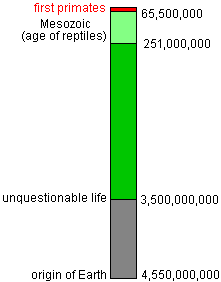 | |||
| Small Insectivore | 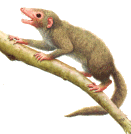 | ||
Primates are remarkably recent animals. Most animal species flourished and became extinct long before the first monkeys and their prosimian ancestors evolved. While the earth is about 4.54 billion years old and the first life dates to at least 3.5 billion years ago, the first primates did not appear until around 50-55 million years ago. That was10-15 million years after the dinosaurs had become extinct.
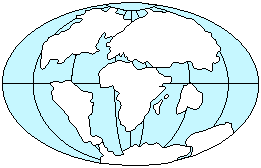 | |
| 65,000,000 years ago | |
| | |
| present |
Transitional primate-like creatures were evolving by the end of the Mesozoic Era (ca. 65.5 million years ago). At that time, the world was very different from today. The continents were in other locations and they had somewhat different shapes. North America was still connected to Europe but not to South America. India was not yet part of Asia but heading towards it at a surprisingly rapid rate of nearly 8 inches (20 cm.) per year. Australia was close to Antarctica. Most land masses had warm tropical or subtropical climates.
The flora and fauna ![]() at the end of the Mesozoic Era would have seemed alien since most of the plants and animals that are familiar to us had not yet evolved. Large reptiles were beginning to be replaced by mammals as the dominant large land animals. Among the mammals, there were a few archaic egg-layers (monotremes) like the ancestors of the platypus and echidna. There were larger numbers of pouched opossum-like mammals (marsupials). The few placental mammals that existed at that time mainly consisted of the Insectivore
at the end of the Mesozoic Era would have seemed alien since most of the plants and animals that are familiar to us had not yet evolved. Large reptiles were beginning to be replaced by mammals as the dominant large land animals. Among the mammals, there were a few archaic egg-layers (monotremes) like the ancestors of the platypus and echidna. There were larger numbers of pouched opossum-like mammals (marsupials). The few placental mammals that existed at that time mainly consisted of the Insectivore ![]() ancestors of primates. Most of the mammal species were small, ranging from about the size of a mouse up to a medium size domesticated dog. The large grass-eating placental mammals, such as cattle and wildebeest, were absent as were the vast grasslands that would later develop. Rodents and seed-eating birds were also absent. The great proliferation of flowering plants had not taken place yet. However, forests of broad-leafed trees were developing over much of the earth.
ancestors of primates. Most of the mammal species were small, ranging from about the size of a mouse up to a medium size domesticated dog. The large grass-eating placental mammals, such as cattle and wildebeest, were absent as were the vast grasslands that would later develop. Rodents and seed-eating birds were also absent. The great proliferation of flowering plants had not taken place yet. However, forests of broad-leafed trees were developing over much of the earth.
Primate-like Mammals
The first primate-like mammals , or proto-primates ![]() , evolved in the early Paleocene Epoch (65.5-55.8 million years ago) at the beginning of the Cenozoic Era. They were roughly similar to squirrels and tree shrews in size and appearance. The existing, very fragmentary fossil evidence (from Asia, Europe, North Africa, and especially Western North America) suggests that they were adapted to an arboreal way of life in warm, moist climates. They probably were equipped with relatively good eyesight as well as hands and feet adapted for climbing in trees. These primate-like mammals ( Plesiadapiformes
, evolved in the early Paleocene Epoch (65.5-55.8 million years ago) at the beginning of the Cenozoic Era. They were roughly similar to squirrels and tree shrews in size and appearance. The existing, very fragmentary fossil evidence (from Asia, Europe, North Africa, and especially Western North America) suggests that they were adapted to an arboreal way of life in warm, moist climates. They probably were equipped with relatively good eyesight as well as hands and feet adapted for climbing in trees. These primate-like mammals ( Plesiadapiformes ![]() ) will remain rather shadowy creatures for us until more fossil data become available.
) will remain rather shadowy creatures for us until more fossil data become available.
 |
The primate-like mammals do not seem to have played an important role in the general transformation of terrestrial animal life immediately following the massive global extinctions of plants and animals that occurred about 65,500,000 years ago. The most dramatic changes were brought about by the emergence of grazing and browsing mammals with tough hoofs, grinding teeth, and digestive tracts specialized for the processing of grass, leaves, and other fibrous plant materials. The evolution of these herbivorous mammals provided the opportunity for the evolution of the carnivorous mammals specialized to eat them. These new hunters and scavengers included the evolutionary lines that would later produce the dogs, cats, and bears of our time. Adaptive radiation was resulting in the rapid evolution of new species to fill expanding ecological niches, or food getting opportunities. Most of these new animals were placental mammals. With the exception of bats, none of them reached Australia and New Guinea. This explains why they did not exist there until people brought them in recent times. South America had also drifted away from Africa and was not connected to North America after 80,000,000 years ago. However, around 20,000,000 years ago, South America reconnected with North America and placental mammals streamed in for the first time, resulting in the extinction of most of the existing marsupials there.
Early Prosimians
The beginning of the Eocene Epoch (55.8-33.9 million years ago) coincides with the emergence of early forms of most of the placental mammal orders that are present today. In addition, placental mammals with larger bodies and bigger brains began to appear in the fossil record at this time. Paul Falkowski has suggested that this is due to the fact that the amount of oxygen in the earth's atmosphere more or less doubled around 50 million years ago. Larger mammals have relatively fewer capillaries for the distribution of oxygen to the cells of their bodies. Subsequently, they must breathe air that is more oxygenated. Brains have especially high oxygen requirements. In addition, pregnant placental mammals must transmit a substantial portion of the oxygen in their blood to their fetuses. Coinciding with the increase in atmospheric oxygen at the beginning of the Eocene Epoch was a relatively abrupt global warming of 9-16� F. (5-9� C.) lasting at least 200,000 years. This also would have been a major factor in the rapid evolution of animals and plants at the time. Overall, climates were significantly warmer during the Eocene than now. There were crocodiles in the Arctic, pine forests in the Antarctic, and palm trees in Wyoming. There was no polar ice. As a consequence, sea levels were close to 330 feet (100 m.) higher than today.
The first true primates evolved by 55 million years ago or a bit earlier, near the beginning of the Eocene Epoch. Their fossils have been found in North America, Europe, and Asia. They looked different from the primates today. They were still somewhat squirrel-like in size and appearance, but apparently they had grasping hands and feet that were increasingly more efficient in manipulating objects and climbing trees. The position of their eyes indicates that they were developing more effective stereoscopic vision as well.
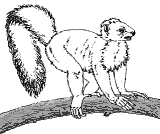 | |
| Smilodectes |
Among the new primate species were many that somewhat resemble modern prosimians such as lemurs, lorises, and possibly tarsiers. The Eocene was the epoch of maximum prosimian adaptive radiation. There were at least 60 genera of them that were mostly in two families--the Adapidae ![]() (similar to lemurs and lorises) and the Omomyidae
(similar to lemurs and lorises) and the Omomyidae ![]() (possibly like galagos and tarsiers). This is nearly four times greater prosimian diversity than today. Eocene prosimians also were much more widely distributed around the world than now. They lived in North America, Europe, Africa, and Asia. It was during this epoch that they reached the island of Madagascar, where they flourished up to modern times. The great diversity of Eocene prosimians was probably a consequence of the fact that they did not have competition from monkeys and apes since these latter more advanced primates had not yet evolved.
(possibly like galagos and tarsiers). This is nearly four times greater prosimian diversity than today. Eocene prosimians also were much more widely distributed around the world than now. They lived in North America, Europe, Africa, and Asia. It was during this epoch that they reached the island of Madagascar, where they flourished up to modern times. The great diversity of Eocene prosimians was probably a consequence of the fact that they did not have competition from monkeys and apes since these latter more advanced primates had not yet evolved.
| 47 million year old | 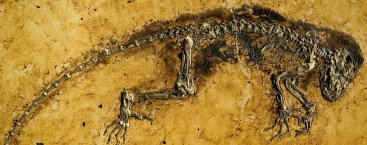 |
Major evolutionary changes were beginning in some of the Eocene prosimians that foreshadow species yet to come. Their brains and eyes were becoming larger, while their snouts were getting smaller. At the base of a skull, there is a hole through which the spinal cord passes. This opening is the foramen magnum ![]() (literally the "large hole or opening" in Latin). The position of the foramen magnum is a strong indicator of the angle of the spinal column to the head and subsequently whether the body is habitually horizontal (like a horse) or vertical (like a monkey). During the Eocene, the foramen magnum in some primate species was beginning to move from the back of the skull towards the center. This suggests that they were beginning to hold their bodies erect while hopping and sitting, like modern lemurs, galagos, and tarsiers.
(literally the "large hole or opening" in Latin). The position of the foramen magnum is a strong indicator of the angle of the spinal column to the head and subsequently whether the body is habitually horizontal (like a horse) or vertical (like a monkey). During the Eocene, the foramen magnum in some primate species was beginning to move from the back of the skull towards the center. This suggests that they were beginning to hold their bodies erect while hopping and sitting, like modern lemurs, galagos, and tarsiers.
| Eocene Era primate (on left) and modern human skulls | 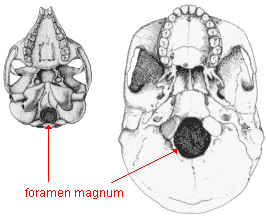 |
By the end of the Eocene Epoch, many of the prosimian species had become extinct. This may be connected with cooler temperatures and the appearance of the first monkeys during the transition to the next geologic epoch, the Oligocene ![]() (about 34 million years ago).
(about 34 million years ago).
Early Monkeys and Apes
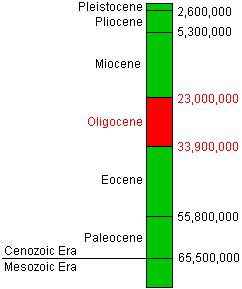 | |
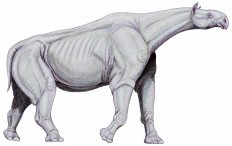 | |
| Hornless rhinoceros (Indricotherium): The largest known mammal from the Oligocene Epoch |
The body size of mammals in many species lines progressively increased after the end of the age of dinosaurs as they took advantage of the vast expanses of land and plant food made available by the extinction of the giant reptiles. The biggest land mammals ever to live evolved by around 39-40 million years ago (near the end of the Eocene Epoch) and flourished during the subsequent Oligocene Epoch (33.9-23 million years ago). The largest of them was a hornless rhinoceros (Indricotherium transouralicum) living in Eurasia that weighed 16.5 tons (15,000 kg.) and stood 18 feet (5.5 m.) at the shoulders. By comparison, the biggest African elephants today weigh 6.7 tons (6,046 kg.) and stand 13 feet (4 m.) at the shoulders.
Unfortunately, the Oligocene Epoch was largely a gap in the primate fossil record in most parts of the world. This is especially true for prosimian fossils. Most of what we know about them came from the Fayum ![]() deposits in Western Egypt. While this area is a desert today, 36-31 million years ago it was a tropical rainforest on the edge of a large lake or sea. Other Oligocene deposits containing some fossil primate bones have been found in North and West Africa, the Southern Arabian Peninsula, China, Southeast Asia, as well as North and South America.
deposits in Western Egypt. While this area is a desert today, 36-31 million years ago it was a tropical rainforest on the edge of a large lake or sea. Other Oligocene deposits containing some fossil primate bones have been found in North and West Africa, the Southern Arabian Peninsula, China, Southeast Asia, as well as North and South America.
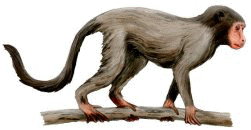 | |
| Old world monkey of the Oligocene Epoch |
Monkeys evolved during the early Oligocene or possibly near the end of the Eocene. Their ancestors were most likely prosimians. These monkeys were the first species of our infraorder--the Anthropoidea . Several genera of early monkeys have been identified. Apidium
![]() and Aegyptopithecus
and Aegyptopithecus ![]() are the most well known. The former was about the size of a fat squirrel (2-3 pounds or .9-1.4 kg.), while the latter was the size of a small dog (13-20 pounds or 5.9-9.1 kg.). Compared to the prosimians, they had fewer teeth, less fox-like snouts, larger brains, and increasingly more forward-looking eyes. These and other anatomical features suggest that the early monkeys were becoming mostly diurnal fruit and seed eating forest tree-dwellers.
are the most well known. The former was about the size of a fat squirrel (2-3 pounds or .9-1.4 kg.), while the latter was the size of a small dog (13-20 pounds or 5.9-9.1 kg.). Compared to the prosimians, they had fewer teeth, less fox-like snouts, larger brains, and increasingly more forward-looking eyes. These and other anatomical features suggest that the early monkeys were becoming mostly diurnal fruit and seed eating forest tree-dwellers.
New World monkeys appeared for the first time about 30 million years ago. It is generally thought that they began as isolated groups of Old World monkeys that somehow drifted to South America either from North America or Africa on large clumps of vegetation and soil. The evidence suggests that Africa is the most likely continent of origin. Such "floating islands" produced as a result of powerful storms tearing at the land still occur in tropical regions of the world today. It is likely that other kinds of small animals were transported to South America in this way as well.
Due to the comparative scarcity of Oligocene Epoch prosimians in the fossil record, it is generally believed that the monkeys out-competed and replaced them in most environments at that time. Supporting this hypothesis is the fact that modern prosimians either live in locations where monkeys and apes are absent or they are normally active only at nighttime when most of the larger, more intelligent primates are sleeping.
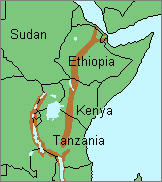 | |
| Great Rift Valley system of |
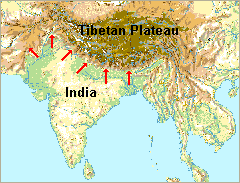 |
| Indian landmass is continuously moving |
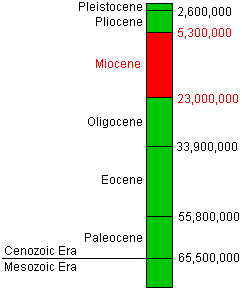 |
The Oligocene was an epoch of major geological change with resulting regional climate shifts that likely affected the direction of evolution and altered fossil preservation conditions. By the beginning of the Oligocene, North America and Europe drifted apart and became distinct continents. The Great Rift Valley system of East Africa also was formed during the Oligocene along a 1200 mile long volcanically active fault zone between tectonic plates that are moving away from each other. This created an easy north-south regional migration route for animals. Around 120 million years ago, the tectonic plate that forms the Indian subcontinent began to rapidly drift north across the Indian Ocean from Antarctica. By 50.5 million years ago, India began crashing into Asia at a rate of 10-12 inches (25-30 cm.) a year and continues to do so today. This has progressively forced up the Himalayan chain of mountains and the high Tibetan Plateau beyond. During the Oligocene, the continuing growth of this immense barrier altered continental weather patterns significantly by redirecting the summer monsoonal rains to the east. This created a vast arid rain shadow region in Central Asia and very likely triggered global climate changes. The cooling and drying trend with associated expansion of grasslands that had begun in the late Eocene Epoch accelerated, especially in the northern hemisphere. A result was the general disappearance of primates from these northern areas. However, climates in most regions were still warmer than today.
By 16-14 million years ago, in the middle of the Miocene Epoch ![]() (23-5.3 million years ago), the ongoing movement of tectonic plates in the Great Rift Valley system created new volcanic mountain chains in east Central Africa. These in turn altered local weather patterns. Some areas became wetter while others more arid due to local rain shadows. In addition, the progressive global cooling trend continued. Growing polar ice caps reduced the amount of water in the oceans, causing sea levels to drop. This exposed previously submerged coastal lands. As a result of this and continental drift, a land connection was reestablished between Africa and Eurasia along the eastern Mediterranean Sea coast that provided a migration route for primates and other animals between these continents. Much of the East African and South Asian tropical forests began to be replaced by sparse woodlands and dry grasslands because of the climate changes. As a result, there were new selective pressures affecting primate evolution.
(23-5.3 million years ago), the ongoing movement of tectonic plates in the Great Rift Valley system created new volcanic mountain chains in east Central Africa. These in turn altered local weather patterns. Some areas became wetter while others more arid due to local rain shadows. In addition, the progressive global cooling trend continued. Growing polar ice caps reduced the amount of water in the oceans, causing sea levels to drop. This exposed previously submerged coastal lands. As a result of this and continental drift, a land connection was reestablished between Africa and Eurasia along the eastern Mediterranean Sea coast that provided a migration route for primates and other animals between these continents. Much of the East African and South Asian tropical forests began to be replaced by sparse woodlands and dry grasslands because of the climate changes. As a result, there were new selective pressures affecting primate evolution.
| | ||
| Miocene Epoch monkey-ape transitional genus | ||
| | Proconsul | |
Primate fossils are common from the Miocene. However, not all primates are equally represented in the fossil record. Apes apparently evolved from monkeys early in this epoch. Fossil monkeys and prosimians are comparatively rare from most of the Miocene, but apes are common. It appears that apes at that time occupied some ecological niches that would later be filled by monkeys. One of the earliest of the monkey to ape transitional primates was Proconsul ![]() . It lived in African forests 21-14 million years ago.
. It lived in African forests 21-14 million years ago.
Among the numerous Miocene primate species were the ancestors of all modern apes and humans. By 14 million years ago, the group of apes that included our ancestors was apparently in the process of adapting to life on the edges of the expanding savannas in Southern Europe. They were very likely members of the genus Dryopithecus ![]() , which were generally similar in appearance to modern African apes. These apes evolved mostly during a relatively short global heat wave that began around 15 million years ago. This caused enough polar ice to melt so that sea levels once again rose 80-130 feet.
, which were generally similar in appearance to modern African apes. These apes evolved mostly during a relatively short global heat wave that began around 15 million years ago. This caused enough polar ice to melt so that sea levels once again rose 80-130 feet.
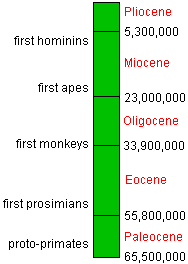 | |
Toward the end of the Miocene, less hospitable cooler conditions in the northern hemisphere once again caused many primate species to become extinct while some survived by migrating south into Africa and South Asia where it remained relatively warm. About 8-9 million years ago, the descendants of the dryopithecines ![]() in Africa diverged into two lines--one that led to gorillas and another to humans, chimpanzees, and bonobos. Around 7 million years ago, a further divergence occurred which separated the ancestors of modern chimpanzees and bonobos from the early hominins
in Africa diverged into two lines--one that led to gorillas and another to humans, chimpanzees, and bonobos. Around 7 million years ago, a further divergence occurred which separated the ancestors of modern chimpanzees and bonobos from the early hominins ![]() (human-like primates) that were our direct ancestors.
(human-like primates) that were our direct ancestors.
Summary
Primates are relative newcomers on our planet. The earliest ones are found in the fossil record dating to 50-55 million years ago. These first prosimians thrived during the Eocene Epoch. There were no monkeys or apes for them to compete with yet. By the time of the transition to the Oligocene Epoch, monkeys had begun to evolve from prosimians and became the dominant primates. Many of the prosimian species became extinct probably as a consequence. By the early Miocene Epoch, apes had evolved from monkeys and displaced them from many environments. In the late Miocene, the evolutionary line leading to hominins finally became distinct. This hominin line included our direct ancestors.
Copyright � 1999-2012 by Dennis O'Neil. All rights reserved.
illustration credits
Source: https://www2.palomar.edu/anthro/earlyprimates/early_2.htm
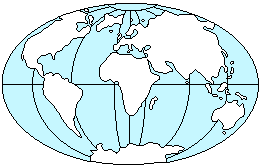
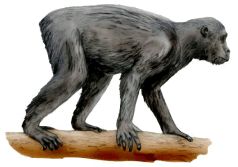
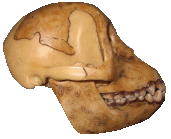
0 Response to "He Evolution of Apes Began in Africa and Continued in"
Mag-post ng isang Komento